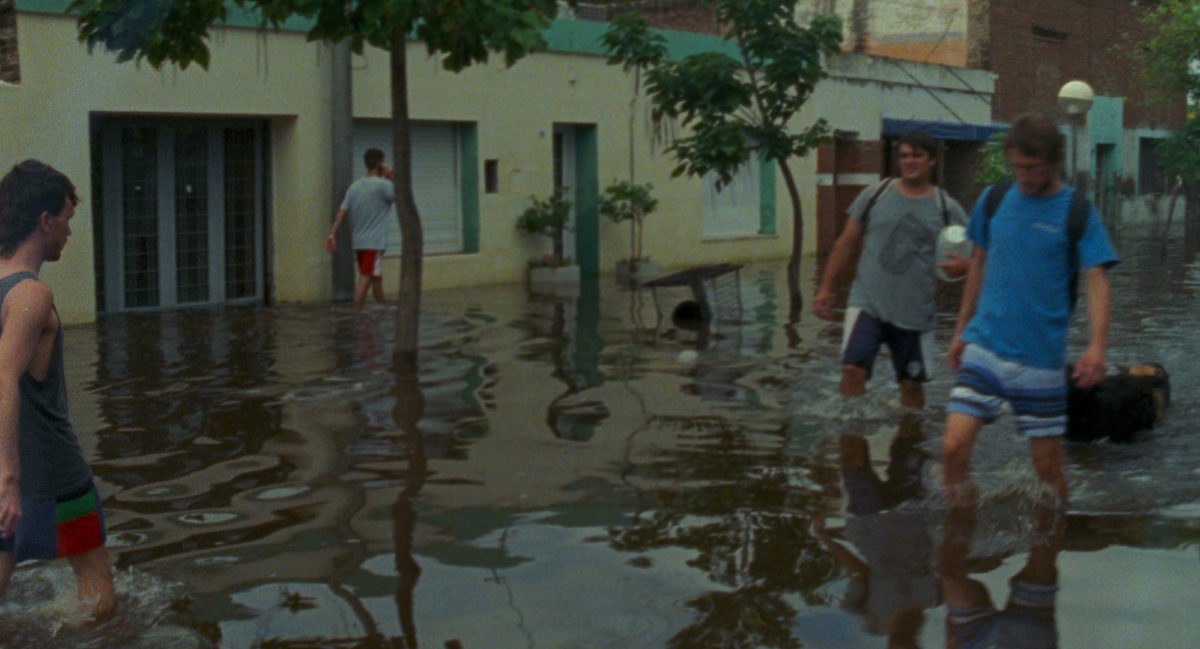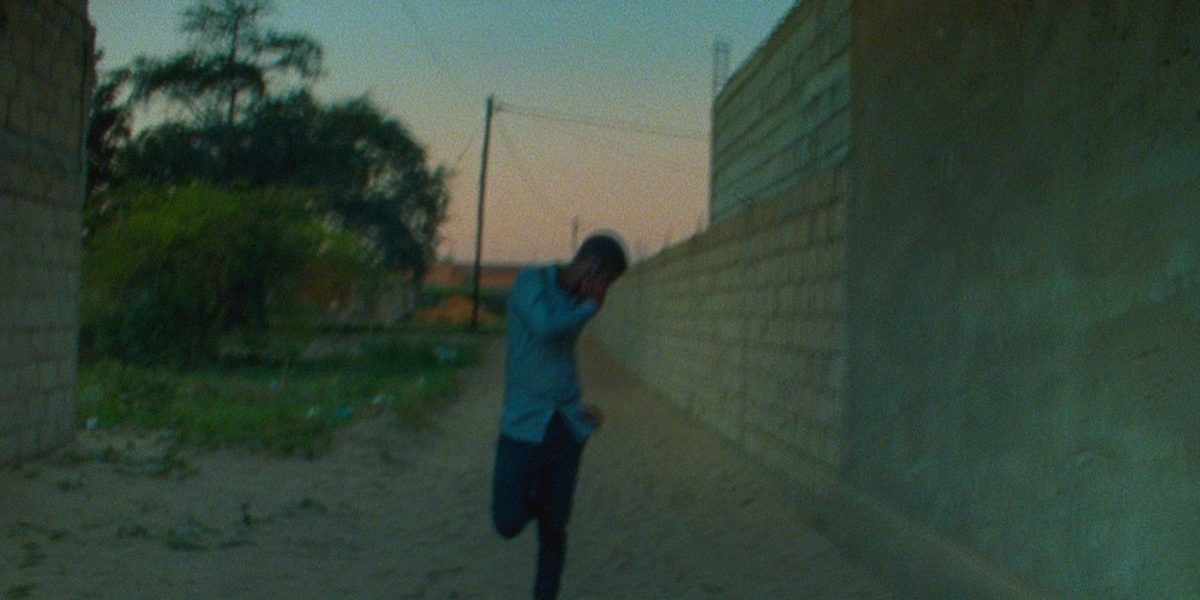Cinea, Filmmagie and Sabzian were asked by Courtisane to each invite a film critic/writer/thinker to attend the festival (March 29 – April 2). Nadin Mai accepted our invitation and wrote this text on Eduardo Williams’ The Human Surge.
One image of Eduardo Williams’ debut feature, The Human Surge, stays with me, and I don’t quite know why that is the case: a young man walks down a street, the camera facing him. He is dressed in a blue suit shirt and talking on the phone. Just when he is framed by two stone walls, one on each side of him, he stops briefly to check his right shoe. In the far background, one can see the end of a sunset, just slightly, through the particular blue and yellow colors in the sky. They speak of the night to come.
The scene is one of many that are simple, yet strong. The director’s use of medium and long shots carefully position the characters in their environment. The characters become their environment, the environment becomes them, and they shape one another. Man is more than just himself. For a couple days after I had seen the film, I wondered what it was about this one scene that had struck me so much.
It is, perhaps, the context of the film. Williams, from Argentina, shows a very specific luxury of modernity: boredom, experienced as a “consistent and often unavoidable part of life in the modern world”, as Julian Jason Haladyn describes it in Boredom and Art – Passions of the will to boredom (2015). Except for a mere two scenes to which I will return below, most images in The Human Surge are simple. Shot in three different countries (Argentina, Mozambique and the Philippines) and in three different formats (16mm, Digital Blackmagic pocket camera footage filmed off a computer screen onto Super 16, and RED Scarlet digital video), the film does not present obvious framing, such as canted, or high and low angles, in order to induce certain emotions in the viewer. What you see is what you get. Williams’ approach reciprocates the characters’ laissez-faire, bored feeling in life. Beyond this, however, is a cinematic representation of a complex condition that is playing out in modern times: the parallel rise of technology and boredom.
Characteristic of this boredom, this nothingness, albeit of a degree of liberté at the same time, is Williams’ recording of almost endless walking. Although in a very different way, Williams’ scenes might remind one of Béla Tarr’s characteristic scenes in Satantango (1994) or Werckmeister Harmonies (2000). Visually, those two films couldn’t be more different from The Human Surge. Yet there is a similar resonance in the depiction of walking; endlessly, repetitively, sometimes with a goal unknown to the audience, perhaps even to the characters themselves. Williams is careful with his camera, keeping it stable, though without losing the visual effect of walking entirely. There is no rush, not even when one character begins to run down a street. Walking suggests time, suggests leisure. It suggests a kind of time the main character in Buenos Aires, Argentina, would not have if he had not been fired again. In his new book Modern Times – Essays on Temporality in Art and Politics (2017), Jacques Rancière refers to Plato’s description of two types of people in society; those who have time and those who do not. In effect, according to Plato, this is very much a distinction between active and passive citizens, the latter merely labouring and resting before their labour starts again. They therefore only exist for work and do not have time for leisure. Today, a few weeks after the screening, it seems to me as though the characters turn this around. The surge Williams mentions in the film’s title is a surge of Plato’s passive citizens against the claustrophobic system of a repetitive work-rest cycle. They attempt to become active citizens, people “whose present”, writes Rancière, “is situated within the time of events that might arrive – the time of action and of its ends, which is also the time of knowledge and of its leisure” (18). They no longer “passively receive time” (18), but instead actively use their time for pleasure and leisure. As Williams said in an interview with Ela Bittencourt for Film Comment: “Normally, work occupies all your time. (…) My characters feel a bit lost, but I think this kind of permission to be lost is also necessary to grow. People are so often afraid, but we need exploration to learn”, and this exploration the director speaks of requires time.

We often equate movement with time. Cinema is a time-based art, a form of art that is based on movement, which means time. With few exceptions in the world of experimental film (the most notable and widely known exception is perhaps Chris Marker’s La Jétée), the movement of images is a given when one watches a film. But I had the feeling that Williams created a cinematic work that relies stronger on time than other films. It does not show in its treatment of on-screen duration. Indeed, the film has a leisurely pace, but the issue of time really shows in the characters’ and the camera’s movement across time and space, or the lack thereof. In stunning transitions, Williams’ camera defies time and space, and moves across continents via two remarkable journeys. One of them leads us from Argentina to Mozambique through a chat window on a computer screen; the other is a fascinating underground journey through an anthill which connects Mozambique and the Philippines. Yet, many scenes in the film, but especially those in the Philippines, speak about the frustration of not being able to connect to the internet, which inevitably suggests stagnation, a stoppage of (virtual) movement, of (virtual) time. Penetrated by a persistent computer-voiced “okay”, the end of the film, which Williams shot in a tablet factory with the help of a static camera, is a fitting image to this stoppage of time and movement that is so central to the film.
It is this tablet factory at the end that wraps up the film’s concern with technology, bringing the visual (and psychological) dominance of it to an end. Williams’s youngsters are almost glued to their mobile phones or the computer screen. This is their connection to the world, to their friends, or even to random people. The latter becomes most evident in two scenes in which groups of young men engage in sexual or quasi-sexual behaviour in front of a webcam in order to gain clicks and money. There is something that I would perhaps describe as “digital prostitution” going on in the film, both in Argentina and in Mozambique. This form of prostitution is a game, a game of excitement, of boredom, something that reminded me of a book I read years ago which dealt with the link between the felt boredom of teenagers in Germany and the increase in explicit sexual behaviour, which was no more than a pastime, a fooling around that killed time. The Human Surge is essentially a film about this: creating time, killing time.
